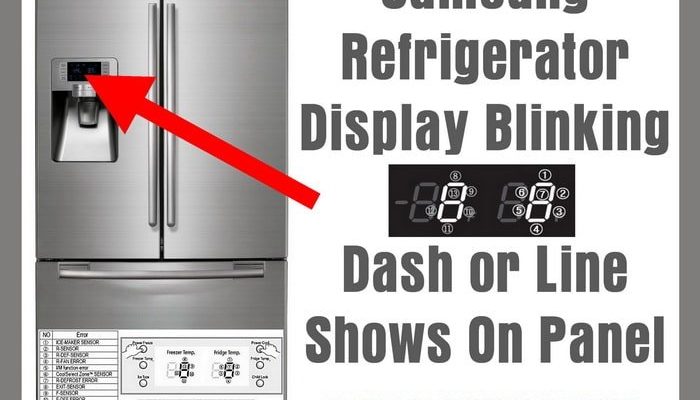
In simple terms, error code E1 on a Samsung refrigerator typically indicates a problem with the refrigerator’s temperature sensor. Simply put, this sensor acts like the brain of your fridge, helping it maintain the right internal climate to keep your food fresh and safe. When the sensor malfunctions, it’s like your refrigerator is trying to navigate without a map, leaving it confused and unable to perform optimally. But don’t worry, fixing this is like pressing a reset button on your favorite gadget—easy once you know how.
Understanding Error Code E1: What’s Really Going On?
Let’s dive a little deeper. Error code E1 is essentially your Samsung refrigerator’s way of waving a red flag, suggesting that the temperature sensor might not be working correctly. Think of the temperature sensor as the thermostat in your home. If it’s out of whack, your home could get too hot or too cold, leading to uncomfortable conditions. In the case of your fridge, improper temperature regulation means your food might not be kept at safe, optimal levels.
So, why does this happen? It could be due to a variety of reasons, such as a disconnected sensor wire, a damaged sensor itself, or even environmental factors like a surge in electricity. Sometimes, it could just be a temporary glitch that needs a simple reset to clear. Like when your smartphone acts up, and a quick reboot seems to solve the mystery. However, if the error persists, it might be indicative of a more significant issue that needs a closer examination.
You’re probably wondering, “Can I fix this myself?” The short answer is yes, often you can. But it’s crucial to handle the situation carefully to avoid causing further issues. Resetting the refrigerator can sometimes resolve the problem, but if it doesn’t, don’t worry—there are other steps you can take to get to the root of the problem.
Step-by-Step Guide to Resetting Your Samsung Refrigerator
Let’s move on to what you came here for: resetting your Samsung refrigerator. Before you get started, make sure you have a bit of time on your hands and some patience. Here’s the deal: it’s not as complicated as it sounds, and you don’t need to be a tech wizard to pull it off.
First, locate the power button or switch on your refrigerator. It’s often cleverly hidden away on the control panel or inside the fridge. Unplugging the refrigerator directly from the power source works too, sort of like unplugging a computer to reboot it. This simple step allows the fridge to power down completely, wiping out any temporary bugs that might be causing the issue.
Next, leave your refrigerator unplugged for about 10 minutes. This waiting period is crucial because it gives the system enough time to reset entirely. Think of it as letting your device catch its breath before starting fresh. Once you’ve waited patiently, go ahead and plug it back in. You should see the display panel light up, hopefully without the dreaded E1 error.
If the error code doesn’t reappear, congrats! You’ve reset your refrigerator successfully. Like a triumphant DIY victory dance, pat yourself on the back. But if the code persists, don’t lose heart. There are a few more steps you can try before calling in the professionals.
What If the Error Code Persists?
So, you’ve tried resetting, and that E1 error is as stubborn as ever. What now? Well, it’s time to do a little detective work. Check if the temperature sensor—the heart of this whole issue—is loose or damaged. This might require you to refer to your refrigerator’s manual because each model may have slight variations in sensor placement.
Consider this: sometimes, external factors could be influencing the error code. Has there been a recent power outage or surge? This could have affected your fridge, causing it to display the error. Ensuring your appliance is plugged into a surge protector can prevent these issues in the future, like wearing a raincoat to avoid getting drenched in a downpour.
If these checks don’t resolve the problem, it might be time to seek professional help. Yes, it’s okay to admit when something’s a little over your head. Contacting Samsung customer support or a certified appliance repair technician can provide the expertise needed to resolve any underlying technical issues.
As a last word of wisdom, regular maintenance can keep your refrigerator running smoothly and prevent these issues from cropping up. Simple practices like cleaning the coils and ensuring proper ventilation can go a long way. Just like regular oil changes keep your car purring, a little TLC keeps your fridge in top condition.
Preventative Tips to Avoid Future Error Codes
No one likes unexpected surprises, especially when they appear as cryptic error codes. So how can you keep these pesky problems at bay? Paying a little extra attention to your refrigerator’s environment and maintenance routine can be your best line of defense.
First off, make sure your refrigerator is positioned correctly. It should have enough space around it for proper ventilation. Cramped spaces can cause overheating and lead to sensor malfunctions, much like when you try to work in a hot, stuffy room—it’s uncomfortable and unproductive.
Next, remember that refrigerators need a stable power source. Frequent fluctuations in power can confuse the internal components. Using a surge protector is a simple way to safeguard against unexpected power spikes, protecting your appliance from potential damage.
Finally, consider setting a reminder to perform regular checks on your refrigerator. Just a quick glance every few months can catch minor issues before they snowball into something bigger. Regular cleaning and ensuring the seals are tight can make a big difference, much like how a quick check-up can keep you healthy.
Don’t let error codes scare you. With these preventative measures and a bit of knowledge, you’ll be well-equipped to handle E1 or any other surprise your refrigerator throws your way. Remember, being proactive is the key to keeping your kitchen running smoothly and your food perfectly chilled.
